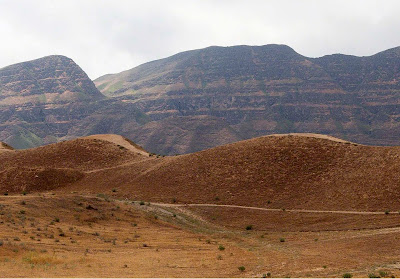Turkmenistan | Nohur | Kopet Dag Mountains
I was extremely eager to see the ruins of the city of Dehistan, 195 miles northwest of Ashgabat as the crow flies. The city was located on the old flood plain of the Amu Darya River back when the river flowed into the Caspian Sea and not the Aral Sea, as it now does. Dehistan was founded by the Khwarezmshahs who ruled the Khwarezmian Empire up until the early thirteenth century when Chingis Khan And His Boys invaded the region. The buildings and minarets found there, now in ruins, are probably the only examples of structures built under the direction of the last Khwarezmshah, Muhammad II. Now you can understand why I was so determined to visit the site.
It is possible to drive to Dehistan directly from Ashgabat, the capital of Turkmenistan. The tourist agency from which I had hired a car and driver suggested, however, that I make a detour through the Kopet Dag Mountains and visit the small village of Nohur, where I would be able to spend the night with a local family. Although I was raring to go to Dehistan I thought that it might be interesting to get of glimpse of the Kopet Tag Mountains on the way and so agreed to the detour.
The Kopet Dag Mountains rearing up along the southern border of Turkmenistan (click on photos for enlargements).
The Kopet Dag Mountains, which constitute the northern edge of the Iranian Plateau, run for some four hundred miles along the southern border of Turkmenistan. From Ashgabat we drove fifty-two miles west through the desert fronting the Kopet Dag to the town of Barharly and then turned southwest onto a gravel road which climbed into the mountains. Nohur is about twenty-four miles from Barhaly as the crow flies, at an attitude of 3100 feet, some 2650 feet above the desert immediately to the north. The Iranian border is just sixteen miles away to the south.
Climbing into the Kopet Dag Mountains. An apricot orchard can see seen in the bottom of the valley.
The village of Nohur is inhabited by an ethnic group known by the same name, the Nohurs. According to one legend, perhaps apocryphal, the Nohurs are descended from the soldiers of the Greek adventurer and gadabout Alexander the Great. Whatever their origins, they are decidedly different from the usual Turkmen and speak a dialect incomprehensible to outsiders. They maintain their ethnic purity by marrying only within the group. Although known for their strict adherence to Islam, elements of animism and Zoroastrianism can be detected in their religious practices. They are also famous for their work ethnic and members of the group who have established businesses in Ashgabat and other cites have achieved considerable wealth and power.
One of the most unusual features of the town of Nohur is the local cemetery. Almost all grave markers are topped by the horns of mountain sheep and ibex collected by local hunters.
Nohur Cemetery
Nohur Cemetery
Nohur Cemetery
Nohur Cemetery
Nohur Cemetery
Nohur Cemetery
Nohur Cemetery
Nohur Cemetery
Nohur Cemetery
Nohur Cemetery
Nohur Cemetery
Nohur is also known for its silk weaving. The silk itself is imported from Iran and hand-woven using traditional local designs.
Silk Weaver. As can be seen, the woman has a scarf over her mouth. Nohur women traditionally wear a scarf over their mouths “so that they will not say silly things,” at least according to local lore.
Silk Weaver
The house where I spent the night. The owners were a man and woman in their sixties. They had a daughter with a small baby who was the apple of everyone’s eye. The woman made a mean mutton plov. They also had wonderful local butter, honey, and cherry juice.
Plateau west of Nohur
Plateau west of Nohur
Ramparts at the edge of the plateau
Village at the base of the ramparts. This village had wonderful honey for sale.
Two silk hangings I bought in Nohur, now in the galleria of my hovel in Zaisan Tolgoi. The painting is by the father of Mongolian Artist Mönkhtsetseg.























